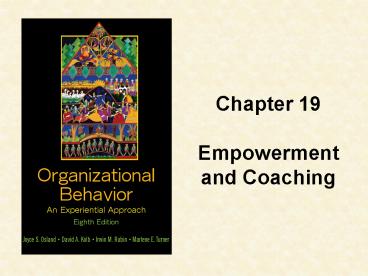Empowerment and Coaching - PowerPoint PPT Presentation
1 / 18
Title:
Empowerment and Coaching
Description:
... personal and professional lives improve performance or enhance quality of life ... differences play a major role in coaching, so mindful communication ... – PowerPoint PPT presentation
Number of Views:86
Avg rating:3.0/5.0
Title: Empowerment and Coaching
1
Chapter 19 Empowerment and Coaching
2
Objectives
- Describe the characteristics of high-performance
organizations - Distinguish between command-and-control and
involvement-oriented approaches of management - Define empowerment
- Explain four aspects of empowerment
19 -1
Organizational Behavior An Experiential Approach
8/E Joyce S. Osland, David A. Kolb, Irwin M.
Rubin and Marlene E. Turner
3
Objectives
- Describe how managers can empower employees
- Identify four different types of coaching
- Explain how culture can impact empowerment and
coaching
19 -2
Organizational Behavior An Experiential Approach
8/E Joyce S. Osland, David A. Kolb, Irwin M.
Rubin and Marlene E. Turner
4
High-Performance Companies
- What characterizes a high-performance company?
- Cost competitiveness
- High quality products and services
- Innovation
- Speed
19 -3
Organizational Behavior An Experiential Approach
8/E Joyce S. Osland, David A. Kolb, Irwin M.
Rubin and Marlene E. Turner
5
Command-and-Control Vs. Involvement-Oriented
Approach
19 -4
Organizational Behavior An Experiential Approach
8/E Joyce S. Osland, David A. Kolb, Irwin M.
Rubin and Marlene E. Turner
6
When Is Command-and-Control Appropriate?
When companies produce simple products or
services in a stable environment
19 -5
Organizational Behavior An Experiential Approach
8/E Joyce S. Osland, David A. Kolb, Irwin M.
Rubin and Marlene E. Turner
7
Empowerment - Defined
- Granting employees the autonomy to
- assume more responsibility within an
- organization and strengthening their sense
- of effectiveness
19 -6
Organizational Behavior An Experiential Approach
8/E Joyce S. Osland, David A. Kolb, Irwin M.
Rubin and Marlene E. Turner
8
Four Aspects of Empowerment
- Meaningtheir work is important
- Competenceconfidence in their ability,
self-efficacy - Self-determinationautonomy to decide how to do
the work - Impactinfluence in their work unit
19 -7
Organizational Behavior An Experiential Approach
8/E Joyce S. Osland, David A. Kolb, Irwin M.
Rubin and Marlene E. Turner
9
How Organizations Can Foster Empowerment
- Reduce hierarchical and bureaucratic structures
- Increase access to sources of system power
(information, resources, managerial support) - Foster organizational culture that values human
assets - Establish direction and boundaries on empowerment
19 -8
Organizational Behavior An Experiential Approach
8/E Joyce S. Osland, David A. Kolb, Irwin M.
Rubin and Marlene E. Turner
10
How Managers Empower Employees
- Solicit input on a regular basis
- Ask for help in solving problems
- Let employees make progressively harder decisions
- Remove bureaucratic obstacles
- Ask questions rather than supplying all the
answers - Provide workers with info they need
- Give employees freedom to respond to customer
needs - Serve as a role model
- Coach employees to mastery
19 -9
Organizational Behavior An Experiential Approach
8/E Joyce S. Osland, David A. Kolb, Irwin M.
Rubin and Marlene E. Turner
11
Managers Still Have To
- Know what is going on
- Set or communicate the direction
- Make decisions subordinates cannot make
- Ensure that employees are on course
- Offer a guiding hand and open doors
- Ensure employees have necessary skills to assume
greater autonomy and responsibility - Ensure employees have information needed to make
decisions - Assess performance
19 -10
Organizational Behavior An Experiential Approach
8/E Joyce S. Osland, David A. Kolb, Irwin M.
Rubin and Marlene E. Turner
12
High Performance-High Commitment Work Cultures
- Characterized by
- Delegation
- Teamwork across boundaries
- Empowerment
- Integration of people and technology
- Shared sense of purpose
19 -11
Organizational Behavior An Experiential Approach
8/E Joyce S. Osland, David A. Kolb, Irwin M.
Rubin and Marlene E. Turner
13
Coaching - Defined
- Coaching is a conversation that follows a
- predictable process and leads to superior
- performance, commitment to sustained
- improvement and positive relationships
19 -12
Organizational Behavior An Experiential Approach
8/E Joyce S. Osland, David A. Kolb, Irwin M.
Rubin and Marlene E. Turner
14
Five Types of Coaching
Coaching
19 -13
Organizational Behavior An Experiential Approach
8/E Joyce S. Osland, David A. Kolb, Irwin M.
Rubin and Marlene E. Turner
15
Professional Coaching
- Ongoing partnership designed to help clients
produce fulfilling results in personal and
professional lives improve performance or
enhance quality of life - Trained to listen, observe and customize approach
to individual needs - Seek to elicit solutions and strategies from
clients
19 -14
Organizational Behavior An Experiential Approach
8/E Joyce S. Osland, David A. Kolb, Irwin M.
Rubin and Marlene E. Turner
16
Positive Regard - Defined
- Positive regard is the unconditional
- acceptance and liking for others
- Characteristic of both effective coaches and
- high-performing managers
19 -15
Organizational Behavior An Experiential Approach
8/E Joyce S. Osland, David A. Kolb, Irwin M.
Rubin and Marlene E. Turner
17
When Does Culture Matter?
- Empowerment less likely to increase job
satisfaction in high power distance cultures but
empowerment is not impossible in high PD cultures - Cultural differences play a major role in
coaching, so mindful communication is crucial - Coaches are safe sounding board for bosses from
high PD cultures
19 -16
Organizational Behavior An Experiential Approach
8/E Joyce S. Osland, David A. Kolb, Irwin M.
Rubin and Marlene E. Turner
18
Indirect Communication Strategies for Coaching
- Mediation a third person is used as a
go-between - Refraction statements intended for person A are
made to person B while person A is present - Metaphors analogies are used to deliver the
message - Hints subtle suggestions are made
19 -17
Organizational Behavior An Experiential Approach
8/E Joyce S. Osland, David A. Kolb, Irwin M.
Rubin and Marlene E. Turner































